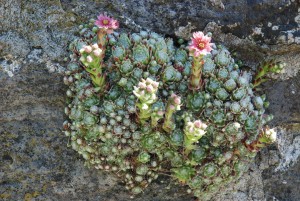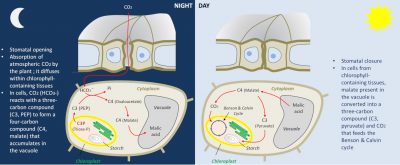The house-leek: example of a plant’s adaptation to environmental constraints
PDFRichard Bligny, Former Director of Research at CNRS, Laboratory of Cellular and Plant Physiology, University of Grenoble Alpes.

Here is an example of physiological and biochemical adaptation to drought in a plant subjected to semi-desert living conditions, almost above ground, with only sporadic water inputs. How does does it works?
Above all, it should be remembered that water available to plant tissues comes from the soil, essentially drawn by fungi associated with the roots (mycorrhizae) to which it is transferred, then distributed in all the compartments of the plant. The second point is that photosynthesis taking in the chloroplasts contained in the leaf chlorophyll-containing tissues requires the simultaneous presence of water, carbon dioxide (CO2) and light. CO2 enters the leaves via pores or gas exchange openings called stomata. The problem is that when stomata are open, water escapes, especially during hot hours of the day when plants receive the most light. Some plants that do not have the ability to close their stomata during the hottest and driest hours wither quickly. This is reflected, for example, in the rare sunny and hot days, for the Kerguelen cabbage, a plant living in the usually cold and very humid islands of the southern hemisphere.
So what about the house-leek and some other plants in arid environments?

Well, these plants open their stomata at night when the atmosphere is saturated with moisture and they capture carbon dioxide: HCO3– binds to a 3-carbon atoms molecule called phophoenopyruvate (PEP) (Figure 2). This reaction forms malic acid (a molecule with 4 carbon atoms, known as C4). During the night, malic acid remains stored in solution in the water of the important aqueous reservoirs of succulent plants, especially in their thick leaves. When daylight arrives, the stomata close to limit water loss, the epidermis of the leaves being by nature not very permeable to water. Then, malic acid releases CO2 and pyruvic acid into the plant tissues in a metabolic process that is the opposite of the one that led to its formation at night. Finally, as it is daytime, photosynthesis can normally take place by combining water and CO2 with the energy provided by light, but here behind closed doors (Figure 2).
In the end, when looking at the balance, an ordinary plant fixes about 3 kg of CO2 by day per litre of transpired water. In the same conditions, a succulent plant able to capturing CO2 at night by forming malic acid and storing it in its large aqueous reservoirs, and then destocking it during daytime, fixes up to 40 kg of CO2 per litre of transpired water. This shows the advantage of both adequate foliar structures and unique metabolism of the crassulacean type (CAM) for plants to keep their water reserves to survive.




